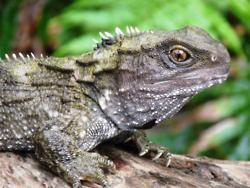fortheloveofherpetology:Tuatara (Sphenodon punctatus)The tuatara is famous because it is the only su
fortheloveofherpetology:Tuatara (Sphenodon punctatus)The tuatara is famous because it is the only survivor of an ancient group of reptiles that roamed the earth at the same time as dinosaursIt hasn’t changed much in over 225 million years. The relatives of the tuatara died out about 60 million years ago which is why the tuatara is called a ‘living fossil’Like bearded dragons and some other lizard species the Tuatara has a parietal eye. This is a specialized scale on the top of the head which detects change in light, allowing for escape from predators such as birdsThis species survived in New Zealand for over 100 million years but rats and people drove them to extinction thereToday they live in well defended burrows on only 37 off-shore islands and mainland islands like the Karori SanctuaryThe total tuatara population on all these islands is estimated to be between 50,000 and 100,000There are two species. (Sphenodon punctatus) is the Cook Strait tuatara which live on Stephen’s Island in the Marlborough Sounds and the Brother’s Island tuatara (Sphenodon guntheri). There are much fewer of the second species. They are slightly smaller than the other tuatara and lived ONLY in a patch of scrub on the top of tiny North Brother Island in the Marlborough Sounds.The Northern tuatara, (Sphenodon punctatus punctatus), is a sub-species which live on offshore islands around the north of the North IslandTuataras can live to be over 100 years old and grow very slowly (they only stop growing at 35 years old)The color of tuatara ranges from olive green to brown to orange-red, and they can change color over their lifetimeThey can hold their breath for an hourThey shed their skin once a yearThis species is not actually defined as a lizardMale tuataras are bigger than the female and have a more prominent crest of spines along its back. They both become sexually mature when they are 15 to 20 years oldA female will be ready to mate only once every two to five yearsThe male will sit outside her burrow and wait. If she is interested they will mate and 8 or 9 months later she will lay and bury 6 to10 eggs in a sunny place. 11 to16 months later the baby tuatara will hatch.Like many reptiles which lay eggs in a nest; temperature decides which sex the eggs will become. The warmer the soil, the greater chance for males.Scientists at Victoria University found that at 22° C, 80% of tuatara incubated would hatch into males, at 20° C, 80% were likely to be females and at 18° C, all the tuatara hatched were female.If global warming continues all Tuatara eggs will be males and the entire beautiful species will go extinctI do not own these images or this information -- source link
Tumblr Blog : fortheloveofherpetology.tumblr.com



